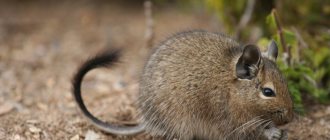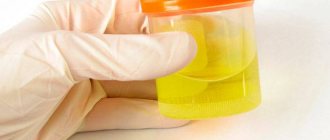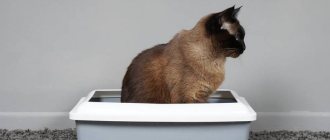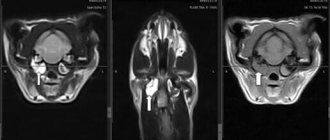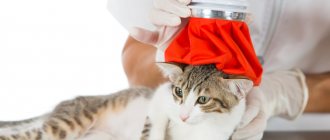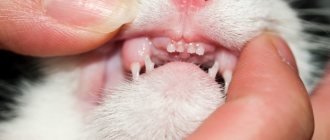7040Administration
The phenomenon of increased protein in a cat's urine is called proteinuria. Protein particles are small, they easily pass through the glomeruli and are therefore excreted along with the urine. If the urine contains protein in small quantities, then this is normal and a physiological process. When protein levels are elevated, this indicates health problems in the cat. In such a situation, it is important to identify the cause of the problem and provide quality treatment.
There are quite a lot of factors for the occurrence of a disorder, and only a veterinarian, after carrying out the necessary tests, will be able to determine why a cat’s urine contains increased protein. The disorder also occurs in dogs.
© shutterstock
Diagnostics
The most common test that will be performed to detect proteinuria is a urine test strip, which checks the contents and composition of the urine. Sometimes the urine may be sent to a laboratory for further testing. If glomerular disease (a condition in which the kidneys are unable to process waste) is suspected, a kidney biopsy may be recommended.
Your veterinarian will try to determine the cause of abnormal levels of protein in your cat's urine. If the condition is thought to be a sign of something more serious, then x-rays and ultrasound can be used to determine the cause.
Biochemical analysis of cat urine - conflicting results
Anonymous user
601 views
April 22, 2020
Hello! I have a sterilized Siberian cat, age 6 years and 4 months, weight 5.5 kg. The cat lives only in the apartment and never goes outside. I feed my cat high-quality dry grain-free food for sterilized cats “Gosbi Original Cat Grain Free Sterilized” (Spain) and canned food for sterilized cats from this manufacturer. This food has a low protein content of 32% (which is less, for example, than ProPlan food for sterilized cats, which has 41% protein). Gosbi food is free of grains, corn and wheat gluten and consists of natural ingredients, including algae, fruits and vegetables rich in natural antioxidants. In accordance with the feeding standards specified by the food manufacturer, as well as age and weight, the cat is given a minimum amount of food, which the cat, as a rule, does not eat completely, which indicates that the cat is not overfed. Also, once a day, along with food, according to the recommended norm, the cat is given Beaphar Malt Paste for hair removal (manufactured in the Netherlands). Regarding the cat’s drinking water, I can explain that (surprisingly), compared to the cats of my friends and relatives, my cat, so to speak, even drinks water with pleasure. In addition to the fact that her water is always fresh, containers with water are placed in the rooms of the apartment, the cat periodically drinks water on her own, so I also supplement the cat with water, bringing her a container of water in the evening (before bed), in the morning and during the day. Therefore, it seems to me that the cat consumes a sufficient amount of water. In my opinion, the cat's urination is normal. In a small way, she walks 2 - 3, and sometimes 4 times during the period from 6.00 to 24.00 hours. In general, a cat usually walks 2 times during the specified period. The cat's behavior is normal - no different from usual, stool and urination are normal. There is constant access to fresh water. I constantly monitor the cat’s health – we periodically take urine tests (general and biochemical); stool analysis, including parasitological examination; blood tests (general and biochemical); SDMA analysis, ultrasound. Regarding the findings of the ultrasound, I can explain that the last time an ultrasound of the abdominal cavity was performed was in the fall of 2021 (unfortunately, I cannot indicate the date, since the results were not found), but before this ultrasound was performed on March 20, 2019, and the results, as I remember, were the same, namely: “moderate hepatosis, impaired renal function, chronic cystitis.” The same results were indicated earlier, even when all the tests in the cat were normal. I can’t say anything bad about the doctor who performed the ultrasound (and this is not the place to evaluate the doctors’ performance or criticize), but it seems that the text of the ultrasound study is always practically the same, and is written as if according to a template. At least, the above conclusion was present both when the cat did not have any deviations from the norm in the tests, and when there were any. Previously (2 years ago), when the cat was fed ProPlan food for sterilized cats (dry and canned), unorganized sediment (single tripel phosphates) systematically began to appear in the cat’s urine and also, at the same time, the level of protein in the urine sometimes increased. Because of this, temporarily (from 2 weeks to 1 month) it was necessary to feed the cat Purina UR medicinal food (dry and canned), as a result of which tripelphosphates disappeared, and the level of protein in the urine returned to normal. The use of Gosbi has eliminated intermittent problems with loose sediment (single tripel phosphates), but urine protein levels are still sometimes higher than normal. QUESTION: Based on the test results below, I ask you to inform me about the supposed reasons for the excess of such important indicators as urine urea, urine creatinine, urine protein and others from the norm against the background of the fact that such important indicators as SDMA, protein ratio are normal /creatinine and urine urea/creatinine ratio (in urine biochemistry), as well as all indicators of a biochemical blood test. I also ask you to inform me about the possible reasons for the excess and decrease (compared to the normative ones) of some indicators of the clinical (general) blood test given below. Are deviations from the norms of some indicators of fundamental importance if they are insignificant? Is it acceptable to use “Purina UR” to lower the level of protein in a cat’s urine, given that previously the use of this medicinal food for from 2 weeks to 1 month normalized the level of protein in the urine along with the removal of unorganized sediment (single tripel phosphates ) and also taking into account the fact that at the moment there is no unorganized sediment and single tripel phosphates? During the next test on March 11, 2020, almost all the indicators of the above tests are normal, with the exception of the following: Clinical (general) urine test: Urine protein (semi-quantitative determination) = 300 mg/dl (with a norm of no more than 30). ? Relative density according to the refractometer (RD) = 1.056 g/cm3 (normal!) pH = 6.5 pH units (normal!) Other indicators are also normal. Biochemical urine analysis: Urea urine = 1512.3 mmol/l (with the norm not exceeding 312)? Excess by 4.8 times. Urine creatinine = 44.8 mmol/l (with the norm not exceeding 25)? Excess by 1.8 times. Urine protein (quantities) = 47 mg/dl (with the norm not exceeding 30)? Excess by 1.6 times. Protein/creatinine ratio = 0.09 (normal!) Urine urea/creatinine ratio = 33.73 mmol/l (normal!) SDMA study = 12 mg/dL (normal!) (average for species 0 -14) Biochemical blood test (all indicators are normal!): Total bilirubin (TBil) = 4.5 µmol/l (normal < 10 µmol/l). Direct bilirubin (DBil) = 3.2 µmol/l (normal < 5.5 µmol/l). ACT (GOT) = 22 U/l (normal 12-45 U/l). ALT (GPT) = 29 U/l (normal 18-60 U/l). Ritis coefficient = 0.7 (norm 1.1 – 1.3). Urea (Urea) = 5.9 mmol/l (normal 5.4 – 12.1 mmol/l). Creatinine (Creat) = 123 µmol/l (normal 70 – 165 µmol/l). Total protein (Prot, total) = 76 g/l (normal 57 – 78 g/l). Albumin (Alb) = 41 g/l (normal 24 – 38 g/l). Excess by 3 g/l. Alkaline phosphatase (ALP, IFCC) = 49 U/l (normal < 55 U/l). Alpha-Amylase, total (α-Amylase, total) = 901 U/l (normal 500 - 1200 U/l). Glucose (Glu) = 4.7 mmol/l (normal 3.3 – 6.8 mmol/l). LDH (LDH, IFCC) = 68 U/l (normal 35 - 500 U/l). Phosphorus (Phosphate, inorg) = 1.48 mmol/l (normal 1.10 – 2.30 mmol/l). Albumin/globulin (A/G Ratio) = 1.18 calculated g/l (normal 0.70 – 1.40 calculated g/l). Globulin (Glob) = 35 g/l (normal 29 – 55 g/l). Urea/Creatinine ratio (B/C Ratio) = 25.4 mg/dl (with azothermia: > 30 pre-/postrenal; < 20 renal A. or other reason) Clinical (general) blood test: All indicators are normal, for with the exception: Hematocrit (Hct, PCV) = 55.1% (with an average norm for the species of 29 - 48%), an excess of 7.1%. Hemoglobin (Hgb) = 183 g/l (with an average norm for the species of 90 – 150 g/l), an excess of 33 g/l. Red blood cells (RBC) = 11.6 x10¹²/l (with an average norm for the species of 5.6 - 10.0 x10¹²/l), an excess of 1.6. Leukocytes (WBC) = 2.9 x10 9 /l (with an average norm for the species of 5.5 - 18.5 x10 9 /l), below the norm by 2.6 x10 9 /l)?. Eosinophils (Eos) = 9% (with an average norm for the species of 0 - 6%), an excess of 3%. ? Corrected (true) leukocytes = 2.9 x10 9 /l (with an average norm for the species of 5.5 - 18.5 x10 9 /l), below the norm by 2.6 x10 9 /l)?. Segmented neutrophils ABS = 1.65 x10 9 /l (with an average norm for the species of 2.50 - 12.50 x10 9 /l), below the norm by 0.85 x10 9 /l)?. Lymphocytes ABS = 0.93 x10 9 /l (with an average norm for the species of 1.50 - 7.00 x10 9 /l), below the norm by 0.57 x10 9 /l)?. When the tests were repeated a month later, on April 18, 2020, approximately the same results were obtained as previously, on March 11, 2020. At the same time, some indicators that deviate from the norm have changed slightly, namely: Clinical (general) urine analysis: Urine protein (semi-quantitative determination) = 100 mg/dl (with a norm of no more than 30). ?. In March 2021, this figure was 300 mg/dL. Relative density according to the refractometer (RD) = 1.072 g/cm3 (at a norm of 1.036 – 1.060 g/cm3), an excess of 0.012 g/cm3. pH = 6.0 pH units (normal and decreased compared to March 2020) Other indicators are also normal. Biochemical urine analysis: Urea urine = 1609.9 mmol/l (with the norm not exceeding 312) ? Excess by 5.2 times. Urine creatinine = 44.2 mmol/l (with the norm not exceeding 25)? Excess by 1.8 times. Urine protein (quantities) = 57.2 mg/dl (with the norm not exceeding 30) ? Excess by 1.9 times Protein/creatinine ratio = 0.11 (normal!) Urea/creatinine urine ratio = 36.43 mmol/l (normal!) I really hope to receive a competent, professional answer. Thank you.
The question is closed
No reward
Treatment
Proteinuria is most often treated on an outpatient basis. If a disease is discovered that affects the kidneys' ability to process waste (such as glomerular disease), dietary changes may be recommended. Conversely, if a cat's kidney is inflamed or there is a high risk of infection, antibiotics may be prescribed.
If the problem is determined to be glomerular disease (eg, glomerulonephritis in cats), dietary changes will be extremely effective. The cat's diet will be low in protein and sodium and high in omega-3 fatty acids.
The cat should be closely monitored as rare but serious complications such as swelling, blood clots, high blood pressure and progressive kidney disease may occur.
Possible symptoms
Proteinuria is not always symptomatic and may be discovered incidentally. In this case, the animal does not show other signs of illness.
This may be the case at a very early stage of the disease or in the case when proteinuria is functional. History alone is not enough to make a diagnosis. The disease develops further, and symptoms characteristic of other pathologies appear.
By carefully observing the animal, you can identify some signs of proteinuria, such as cloudy urine, blood-streaked urine, weakness, vomiting, loss of weight and appetite. If your cat exhibits even one or two of these signs, it is important to seek help from a veterinarian as soon as possible in order to determine the source of the disease earlier.
Types of proteinuria
Proteinuria can be functional (physiological) and pathological. The first is harmless; it is a temporary reaction to sudden physical activity, overheating, hypothermia, or food high in protein. The indicator usually returns to normal when the provoking effect on the body stops, for example, when the cat’s diet changes.
The pathological form develops against the background of any disease and is divided into:
- Prerenal, when small protein molecules enter the kidneys from the blood, penetrating through the filtration barrier.
- Postrenal - protein fractions are formed in the urinary tract as a result of their inflammation. Most often, this form develops due to a bacterial infection.
- Renal, which is caused by functional or anatomical disorders of the kidneys. In this case, the appearance of protein in urine is the result of inflammation or damage to parenchymal tissue.
In some cases, protein is detected in a cat's urine by chance, without any other signs of illness. This is possible with functional proteinuria, or in the initial period of the pathological form of the disease. With the further development of the disease, symptoms inherent in many pathologies may appear, so it is unrealistic to make a diagnosis based on the anamnesis alone.
You can assume that a cat has proteinuria if the animal:
- loss of appetite;
- it quickly loses weight;
- weakness, apathy are observed;
- vomiting often occurs;
- The urine is cloudy and blood fragments can be found in it.
Important! If a cat has at least some of these symptoms, this is a reason to urgently contact a veterinary clinic in order to find the cause of the disease as early as possible. Proteinuria is one of the pathologies, the success of its treatment largely depends on the accurate identification of the provoking disease and timely initiation of therapy.


